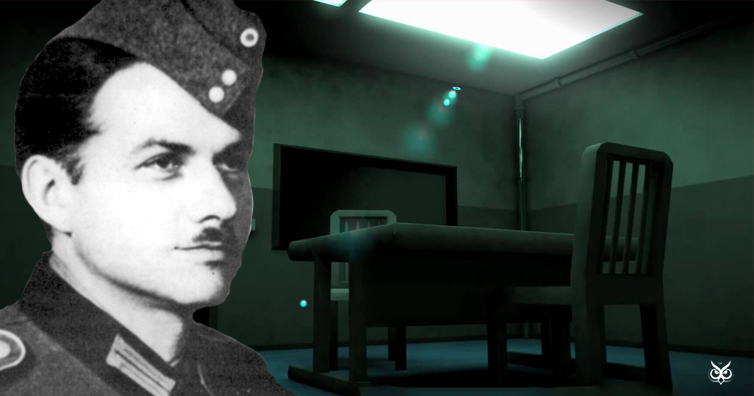Hanns Scharff, a German WWII pilot interrogator, is considered the most successful interrogator of all time. In fact, he was so successful, he helped in shaping the U.S. interrogation techniques after the war. But how did he do it?
According to his own words, Scharff developed several techniques that helped him in his interrogations. First of all, instead of torturing or degrading prisoners, Scharff offered them courtesy and what appeared to be consideration. Instead of attempting to coerce or persuade with offers of booze and prostitutes, Scharff and his fellow officers took prisoners to whatever cinema shows were available at camp, and even shared tea and coffee with them, when they could get it.
According to Scharff, Prisoner of War (POW) interrogations should consist of three phases. First is to help the POW relax and feel comfortable by making small talk about anything at all. Second, after he’s loosened up, the questioner should try to get the prisoner to reveal any military information or plans that he might know, ideally without letting him realize he has said anything of value. Third, the interrogator must write an evaluation report that is truthful, and that contains any and all information that might be useful to commanding officers in the field. (the article continues after the ad)
Scharff proved to be a master at “perspective taking,” the ability to discern the thoughts, feelings, and motivations of others, and he seemed to be able to enter and understand the minds of those he interrogated. These skills enabled him to elicit important information from prisoners without force or coercion. Furthermore, he was very good at concealing the nature of the information he sought, and never reveale any success or failure to his target. Prisoners thus often believed they had given Scharff nothing, certainly nothing of importance.
In initial interrogations, which were handled not by Scharff but by officers in the primary screening room, interrogators routinely asked three questions: What is your name? What is your rank? What is your serial number? The prisoner was then taken back to his cell for a while. His second meeting would be with “Stone Face” Scharff, although the POW and Scharff might have met previously because Sharff often escorted prisoners to and from formal interrogations.
Prisoners were often surprised by Scharff’s office and his reception, especially the fact that Scharff was a private, not an officer. Scharff maintained proper military courtesy and respect for the pilots, and he had an expert command of English; these were not the characteristics prisoners expected of a German interrogator. After receiving a prisoner, Scharff would leave him alone for a little while in his office, which was purposely furnished with American magazines, cigarettes, and posters of pin-up girls; the furnishings and decorations were all designed to make a prisoner feel more “at home,” so he would relax and begin to lower his guard.
When Scharrf returned, his next moves were designed to get information beyond a prisoner’s name, rank, and serial number. Prisoners were often dressed in civilian clothes, which they had put on to try to evade capture. Scharff would tell a prisoner he needed some proof or confirmation that the man really was a pilot, not a spy, and thus entitled to treatment as a prisoner of war. Scharff would go on to say that if he didn’t get that confirmation, the prisoner might be treated as a spy. At that point, instead of making threats, he would ask the POW to imagine how a spy might be treated. The POW knew a spy was likely to be shot, while a combat soldier was entitled to all the rights and privileges offered by the Hague and Geneva Conventions.
Of course, Scharff did not work alone. One of the most important people in his organization was Frau Biehler, who headed a bureau called BUNA-Beute und Nachrichten Abtilung. Toliver describes Biehler this way: She was a tireless, obliging, and proud manageress. Her knowledge was paramount and with the information she and her staff gathered about Air Forces from all countries; units stationed in Africa, England, or wherever; names, medals, letters, newspaper clippings, identification papers forged by the French underground, photographs, etc., they were able to establish where the POWs came from, their units, if they flew fighters or bombers, and type of aircraft, and other identification factors.
Scharff used the information that Frau Biehler and her staff provided to create a “we already know everything” illusion for the prisoner. Rather than ask questions, Sharff would proceed to tell the POW all about his unit and its leadership, and anecdotes about its mission, leading the POW to believe that Scharff knew it all. A prisoner who believes that the interrogator already knows everything believes he has nothing to lose by answering questions; since the interrogator has the answers it makes little sense to deny the information.
According to analyst Pär Anders Granhag, Scharff’s technique consisted of five basic tactics:
1) Creating the “we-already-know-everything” illusion
2) Taking a friendly approach
3) Not pressing for information
4) Confirming and disconfirming information
5) Ignoring important information as it was obtained.
“The Scharff-technique,” he concluded, “is an umbrella concept” involving a number of tactics, whose combination was of key importance.Many books and manuals that have come out since the Second World War recognize the significance of Hanns Joachim Scharff’s interrogation technique, a method which proved to be very effective.
If you like what you read, then you will definitely love this one: This Is How Agents Could Tell If A Safe House Was Convenient To Visit During WWII


Source: globalecco.org
Photos: PRX, Neeraj Pattani / Youtube
Photoshop: I’m A Useless Info Junkie
Widget not in any sidebars



